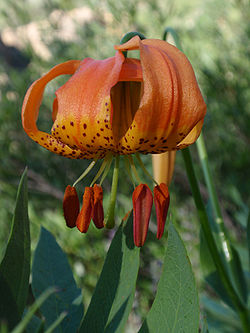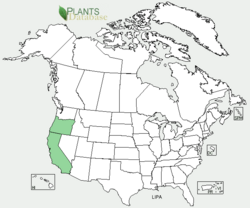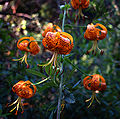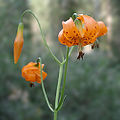Leopard lily
| Leopard lily |
|---|

|
| Scientific Classification |
|
| Subtaxa / Binomial Name |
|
Lilium pardalinum |

|
| Habitat Range |
The Leopard Lily is a species of lily known by the scientific name Lilium pardalinum. The bright colors of flowers are very rarely as bright and admirable as that of the Leopard lily. It can sometimes be mistaken for a Tiger lily. They both have a certain gene that causes there petals to become reflexed back, which in turn makes it just as alluring as any other exotic flower. The Blackberry lily is also often called the leopard lily due to similar spot patterns.
Anatomy
The anatomy of a Leopard Lily is like most flowers but differs in size and color. This species of lily usually grows in damp meadows or next to streams. The stems can grow to be three to seven feet tall. The petal of a Leopard Lily grows linear and is either a bright reddish - orange or just bright red. All petals have purple spots near the bottom.[1]
The flowers of a Leopard lily are three inches wide. They have a dignified and delicate look to them. A stem produces up to 20 flowers in one season. The petals have a bell like shape because they are reflexed back. In the center of the flower is the pistil which is made up of the stigma, style and ovary. The pistil is jar shaped. At the top is the stigma which is sticky to catch the pollen. The pollen then travels down the pollen tube that attaches to the ovary through the style.
The pollen comes from the male part of the flower called the stamen. The stamen is made up of the anther which is held up by the filament. The anther is a spongy oval shaped tip that contains the pollen. The pollen causes the anther to be orange.[2]
Reproduction
Reproduction of a lily is very interesting. Once the flower grow to it's full maturity it can begin reproduction. Through meiosis the male part or stamen of the lily produce the pollen or sperm of the flower. Before the plant is ready to reproduce the inside of the pistil or female part must prepare. The ovule contains a zygote and endosperm, which fuse. The ovary then produces a pollen tube, this grows from the inside of the ovary through the style and out the stigma. Wind, bugs or even humans aid in pollen germination. The pollen blown or brushed off onto the stigma of the same flower or another on the same bush. It could even be carried to a bush miles away. The pollen then travels down the pollen tube to fuse with the ovary. And this ends in the seed. [3]


